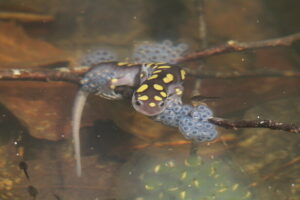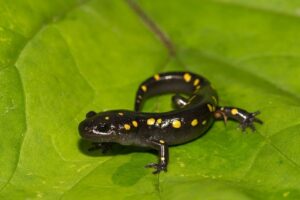Salamanders are quiet creatures that live hidden lives, but their reproduction is surprisingly complex. They breed in forests, ponds, caves, and streams, often without making a sound. So it’s natural to wonder: do salamanders reproduce sexually or asexually?
Salamanders reproduce sexually. They need both a male and a female to make babies. Asexual reproduction, where an animal can reproduce without a mate, does not happen naturally in salamanders. Even though their methods may be unusual, all known salamanders rely on sperm and eggs to create new life.
All Salamanders Use Sexual Reproduction
Sexual reproduction means that two salamanders are involved, one male and one female. The male provides sperm, and the female produces eggs.

The sperm and egg join together to begin a new life. This is true for all salamanders, even the ones that give birth to live young instead of laying eggs.
In most cases, salamanders don’t mate the way mammals do. There is usually no direct physical mating. Instead, the male uses a method called a spermatophore to transfer sperm to the female in a quiet and subtle way.
What Is a Spermatophore?
A spermatophore is a small package of sperm. The male salamander places it on a surface, like a rock, leaf, or pond bottom.
Then he gently guides the female over the spot. When she steps over the spermatophore, she pulls it into her body using a special opening called the cloaca.
This process is calm, slow, and often looks like a kind of silent dance.
The male nudges or circles the female until she picks up the sperm. Once this happens, she can use it to fertilize her eggs.
Some females can even store the sperm for weeks or months.
That means they can wait until the right time before laying eggs. This helps salamanders survive in places where the environment changes quickly.
Do All Salamanders Use This Method?
Most salamanders use spermatophores and internal fertilization, but not all species follow the same routine.
Some aquatic salamanders, like newts and mudpuppies, may have more direct mating contact.
A few species may even release sperm and eggs into the water, allowing them to mix outside the body.
But no matter the method, the result is the same. Salamanders need both sperm and eggs to make young. There are no wild salamanders that reproduce completely on their own.
Do Salamanders Lay Eggs?
Yes, most salamanders lay soft eggs. These eggs are usually placed in water, on plants, or tucked under damp leaves or moss.
They’re covered in a jelly-like coating that keeps them moist.

The number of eggs depends on the species. Some lay just a few at a time. Others lay hundreds. Most salamanders do not stay with their eggs after laying them. The eggs are left to develop on their own in wet, safe places.
A few species, like fire salamanders, give birth to live larvae instead of laying eggs. But even in those cases, reproduction still begins with sperm and eggs inside the female’s body.
What About Asexual Reproduction?
Salamanders do not reproduce asexually in the true sense. Asexual reproduction means that an animal can make babies without a mate.
It means the female’s body makes new life by itself. That doesn’t happen in any known wild salamander.
However, there are some rare exceptions that might seem confusing.
A group of hybrid salamanders in North America, called the Ambystoma complex, are all female. These salamanders use a strange method called kleptogenesis.
They take sperm from males of other species, but they don’t always use the sperm’s DNA.
Sometimes the sperm only triggers the egg to develop, without adding new genetic material.
Even in these cases, though, the female still needs the presence of sperm to start the process. She can’t reproduce without it. So while it’s unusual, it’s still not true asexual reproduction.
Can Salamanders Clone Themselves?
No, salamanders cannot clone themselves. Even in species with odd reproduction methods, each baby still develops with help from sperm. The sperm might not always pass on full DNA, but it’s still needed to start development.
Some salamanders can grow back lost parts, like toes, tails, and even bits of organs. But regeneration is not the same as reproduction.
Making a new toe is not the same as making a new salamander.
Why Sexual Reproduction Helps Them Survive
Sexual reproduction is more work than cloning, but it has a big advantage. It creates variety. Each young salamander gets a different mix of traits from both parents.
That mix helps some survive if things go wrong.

If all salamanders were exact copies, one disease or change in climate could wipe them all out. But if they’re all a little different, some will likely survive. Over time, this keeps the species strong.
This is one reason why sexual reproduction is so common in nature, even among animals that don’t seem very social.
What Happens If a Salamander Can’t Find a Mate?
If a salamander can’t find a mate, it won’t be able to reproduce. Some females store sperm from earlier encounters. This allows them to wait and lay eggs later, even if there’s no male nearby.
But if she has never met a male and doesn’t have stored sperm, no babies will be made. Salamanders don’t lay eggs just for practice. Fertilization must happen first.
This is why breeding usually happens during certain times of year, when conditions are right.
Warm weather, rain, and spring flooding often cause many salamanders to move toward ponds or streams to mate. Timing is important.
Do Salamanders Care for Their Young?
Most salamanders do not take care of their eggs or young. After the eggs are laid, the parents leave. The eggs hatch on their own, and the larvae must find food and survive without help.
A few species do offer some care. Some guard their eggs until they hatch. Others stay near the babies for a short time.
But these are rare exceptions. In most cases, salamanders produce many eggs and leave them behind, hoping that a few will survive.
Conclusion
So do salamanders reproduce sexually or asexually? The answer is clear. Salamanders reproduce sexually.
They need both a male and a female. The male provides sperm, the female provides eggs, and together they create the next generation.
Asexual reproduction doesn’t happen in wild salamanders. Even the rare cases that look different still need sperm to start the process.
Salamanders don’t clone themselves, and they don’t reproduce alone.
Their lives may be quiet and hidden, but their reproductive methods are full of mystery, variety, and clever survival strategies.
And that’s part of what makes salamanders such fascinating creatures.
Hi, my name is Ezra Mushala, i have been interested animals all my life. I am the main author and editor here at snakeinformer.com.

